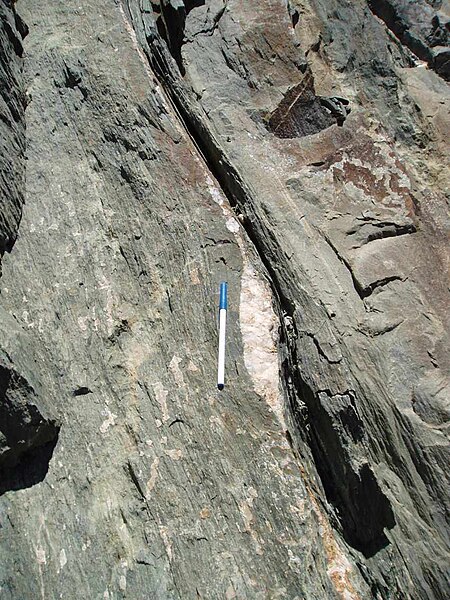In structural geology, strain partitioning is the distribution of the total strain experienced on a rock, area, or region, in terms of different strain intensity and strain type. This process is observed on a range of scales spanning from the grain – crystal scale to the plate – lithospheric scale, and occurs in both the brittle and plastic deformation regimes. The manner and intensity by which strain is distributed are controlled by a number of factors listed below.
Block diagram illustrating strain partitioning at an oblique convergent margin. The obliquity of plate convergence (blue arrows) induces stress components that are normal to the margin (yellow arrow) and parallel to the margin (green arrow). Elevated magnitudes of the arc parallel component induces horizontal translation (red arrows) between the wedge and the backstop. Adapted and modified from Platt, 1993.
Block diagram illustrating the difference between homogeneous and partitioned strain within transpressive and transtensive tectonic regimes. The partitioning of strain occurs through the development of a strike slip or shear zone (shown with red arrows) across the actively deforming region (brown). Adaptation and modification from (Teyssier et al., 1995; Fossen, 2012; Jones and Tanner, 1995; Sanderson and Marchini, 1984)
Conceptual illustration of strain factorization. This highlights how the order of superposition of pure and simple shear components produce differing geometries, as matrix multiplication is non-commutative. Adaptation and modifications from Ramsay and Huber, 1983; Ramsay and Huber, 1987
Simplistic illustration of different deformation mechanisms which produce the finite strain. Citation for different types of deformation mechanisms acquired from (Passchier and Trouw, 2005)
In geology, shear is the response of a rock to deformation usually by compressive stress and forms particular textures. Shear can be homogeneous or non-homogeneous, and may be pure shear or simple shear. Study of geological shear is related to the study of structural geology, rock microstructure or rock texture and fault mechanics.
Boudinaged quartz vein (with strain fringe) showing sinistral shear sense, Starlight Pit, Fortnum Gold Mine, Western Australia
Asymmetric shear in basalt, Labouchere mine, Glengarry Basin, Australia. Shear asymmetry is sinistral, pen for scale
Dextral slickenside of pyrite
Typical example of dextral shear foliation in an L-S tectonite, with pencil pointing in direction of shear sense. Note the sinusoidal nature of the shear foliation.








